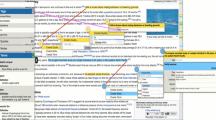Abstract
Data management is central to many CS innovations: Smart home technologies and the Internet of Things, for example, are based on processing data with high velocity. One of the most interesting topics emphasizing several challenges in this field is real-time data analysis. In secondary CS education, it is only considered marginally. So far, there are no tools suitable for general-purpose real-time data analysis in school. In this paper, we discuss this topic from a secondary CS education perspective. Besides central concepts and differences to traditional data analysis using relational databases, we describe the development of a general-purpose \(\textsf {Snap}{\textit{!}}\) extension that allows accessing and processing data from various sources. Thereby, students are enabled to conduct data analyses using, for example, sensor data or web APIs. With the example of a weather station, we outline how this tool can be used in school for analyzing sensor data generated in the classroom.
Access this chapter
Tax calculation will be finalised at checkout
Purchases are for personal use only
Similar content being viewed by others
Notes
- 1.
The “continuous query language” (CQL) is similar in syntax to SQL, but in particular allows using “sliding windows”, which makes it suitable for data stream analysis (cf. [1]).
- 2.
Soft real-time allow even frequent misses of the deadline, as only service quality is being influenced (cf. e.g. [3]).
- 3.
Hard real-time strongly requires adherence to a deadline, as exceeding it results in a system failure. Firm real-time tolerates missing the given deadline infrequently, but the analysis results become irrelevant after the deadline and the quality of service is degraded.
- 4.
“A data stream is a real-time, continuous, ordered (implicitly by arrival time or explicitly by timestamp) sequence of items. It is impossible to control the order in which items arrive, nor is it feasible to locally store a stream in its entirety.” [4].
- 5.
- 6.
We limited processing of queries to one time per second to prevent performance issues. Yet, this limit can easily be changed by modifying the block in \(\textsf {Snap}{\textit{!}}\).
- 7.
- 8.
An exemplary project was described by the Raspberry Pi Foundation: https://www.raspberrypi.org/blog/school-weather-station-project/.
- 9.
References
Arasu, A., Babu, S., Widom, J.: The CQL continuous query language: semantic foundations and query execution. VLDB J. 15(2), 121–142 (2006)
Babcock, B., Babu, S., Datar, M., Motwani, R., Widom, J.: Models and issues in data stream systems. In: Proceedings of the 21th ACM SIGMOD-SIGACT-SIGART Symposium on Principles of Database Systems, pp. 1–16. ACM, New York (2002)
Lee, E.A., Seshia, S.A.: Introduction to Embedded Systems. MIT Press Ltd., Cambridge (2017)
Golab, L., Özsu, M.T.: Processing sliding window multi-joins in continuous queries over data streams. In: Proceedings of the 29th International Conference on Very Large Data Bases (VLDB 2003), vol. 29, pp. 500–511. VLDB Endowment (2003)
Grillenberger, A., Romeike, R.: A Comparison of the field data management and its representation in secondary CS curricula. In: Proceedings of WiPSCE 2014. ACM, Berlin (2014)
Grillenberger, A., Romeike, R.: Analyzing the Twitter data stream using the snap! Learning environment. In: Brodnik, A., Vahrenhold, J. (eds.) ISSEP 2015. LNCS, vol. 9378, pp. 155–164. Springer, Cham (2015). https://doi.org/10.1007/978-3-319-25396-1_14
Grillenberger, A., Romeike, R.: Teaching data management: key competencies and opportunities. In: Brinda, T., Reynolds, N., Romeike, R. (eds.) Proceedings of KEYCIT 2014. Universitätsverlag Potsdam (2014)
Harvey, B., Mönig, J.: Snap! Reference manual (2014). http://snap.berkeley.edu/SnapManual.pdf. Accessed 09 July 2017
Krämer, J.: Continuous Queries over Data Streams - Semantics and Implementation. Philipps-Universität Marburg (2007)
Laney, D.: 3D data management: controlling data volume, velocity, and variety. Technical report, META Group, February 2001
Mäenpää, H., Varjonen, S., Hellas, A., Tarkoma, S., Männistö, T.: Assessing IoT projects in university education: a framework for problem-based learning. In: Proceedings of the 39th International Conference on Software Engineering, pp. 37–46. IEEE Press, Piscataway (2017)
Mayer-Schönberger, V., Cukier, K.: Big Data: A Revolution That Will Transform How We Live, Work, and Think. Houghton Mifflin Harcourt (2013)
Nittel, S.: Real-time sensor data streams. SIGSPATIAL Spec. 7(2), 22–28 (2015)
Author information
Authors and Affiliations
Corresponding author
Editor information
Editors and Affiliations
Rights and permissions
Copyright information
© 2017 Springer International Publishing AG
About this paper
Cite this paper
Grillenberger, A., Romeike, R. (2017). Real-Time Data Analyses in Secondary Schools Using a Block-Based Programming Language. In: Dagienė, V., Hellas, A. (eds) Informatics in Schools: Focus on Learning Programming. ISSEP 2017. Lecture Notes in Computer Science(), vol 10696. Springer, Cham. https://doi.org/10.1007/978-3-319-71483-7_17
Download citation
DOI: https://doi.org/10.1007/978-3-319-71483-7_17
Published:
Publisher Name: Springer, Cham
Print ISBN: 978-3-319-71482-0
Online ISBN: 978-3-319-71483-7
eBook Packages: Computer ScienceComputer Science (R0)




